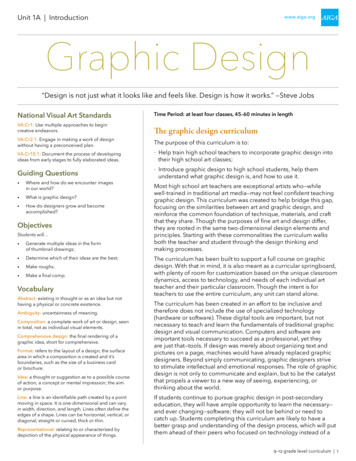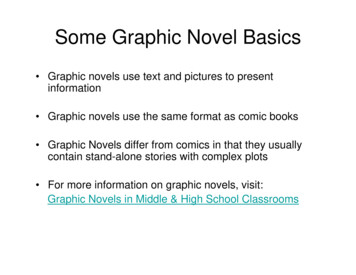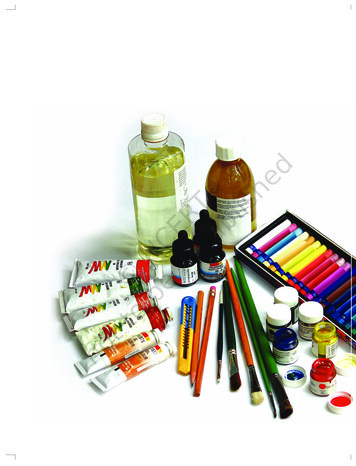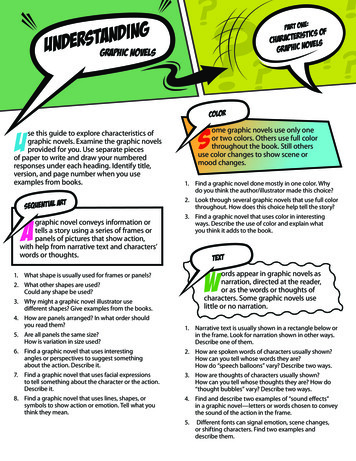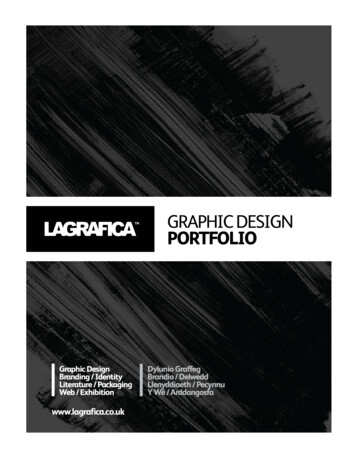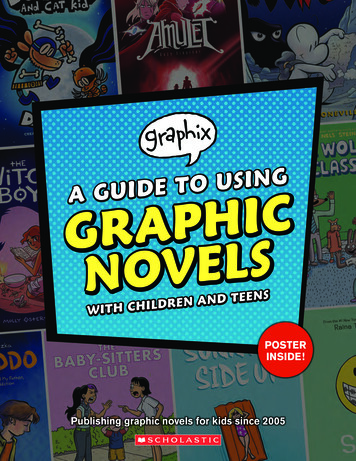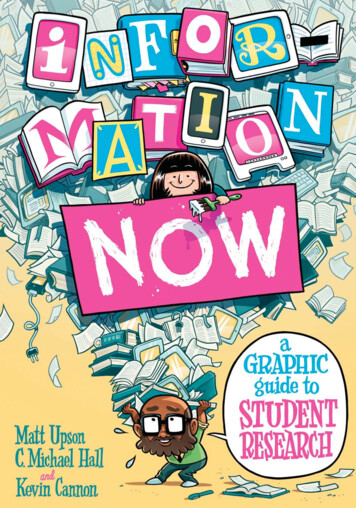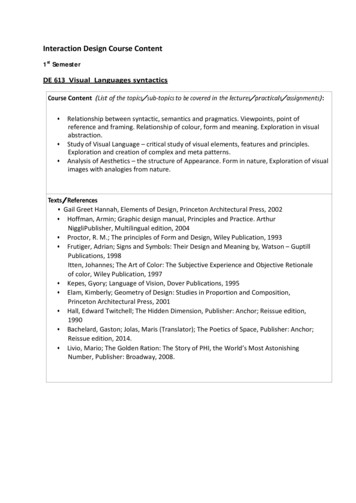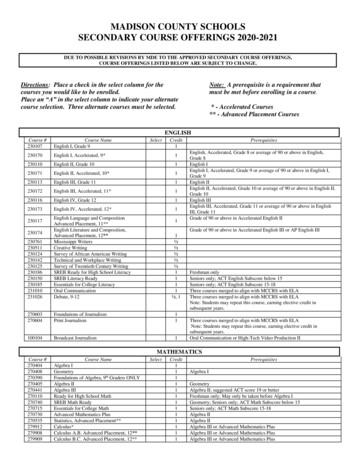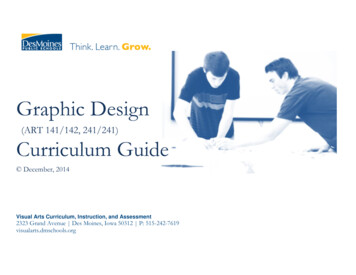
Transcription
Graphic Design(ART 141/142, 241/241)Curriculum Guide December, 2014Visual Arts Curriculum, Instruction, and Assessment2323 Grand Avenue Des Moines, Iowa 50312 P: 515-242-7619visualarts.dmschools.org
Graphic Design (Art 141/142, 241/242) Curriculum GuideSuperintendentThomas Ahart, Ed.DExecutive Director of Secondary Teaching & LearningNoelle TichyVisual Arts Curriculum CoordinatorSarah DoughertyGraphic Design Curriculum EditorsBryan Butcher – North High SchoolJudy Lee – East High School1
Graphic Design (Art 141/142, 241/242) Curriculum GuideForewordCurriculum in this document is based on the National CoreMedia Arts Standards published in the spring of 2014. It has beendeveloped by visual art educators and curriculum specialists inthe Des Moines Public Schools. The objectives in this curriculumguide are the minimum requirements in the visual arts that setrigorous, relevant, clear, and measurable learning targets andexpectations for what teachers should teach and students shouldlearn. Schools and educators are continuously encouraged to gobeyond these targets to better serve the needs of all students inthe visual arts.Definition of the Visual ArtsVisual arts include the traditional fine arts such as drawing,painting, printmaking, photography, and sculpture; media artsincluding film, graphic communications, animation, and emergingtechnologies; architectural, environmental, and industrial artssuch as urban, interior, product, and landscape design; folk arts;and works of art such as ceramics, fibers, jewelry, works in wood,paper, and other materials. –National Art Education Association2
Graphic Design (Art 141/142, 241/242) Curriculum Guide Table of ContentsHow to use this document .4DMPS Art Learning Objectives .5Document Structures .6Reporting Clusters .7-11Design Concepts: Elements and Principle. .7Studio Skills: Media, Tools, and Processes . .8Critical Analysis: Planning . .9Critical Analysis: Evaluating . .10Assessment Rubrics .12Common Vocabulary .14Elements of Art . 15Principles of Design . .16Four-Step Critical Analysis Process . .173
Graphic Design (Art 141/142, 241/242) Curriculum GuideHow to use this document:This curriculum guide is not A lock-step instructional guide detailing exactly when and how you teach.Meant to restrict your creativity as a teacher.A ceiling of what your students can learn, nor a set of unattainable goals.Instead, the curriculum guide is meant to be a common vision for student learning and a set ofstandards by which to measure and report student progress and provide meaningful feedback.The curriculum guide outlines which learning goals are most essential for student learning; it is our district’s guaranteed and viablecurriculum. The expectation is that every student in our district, regardless of school or classroom, will know and understand theselearning goals. As the classroom teacher, you should use the curriculum guide to help you to decide how to scaffold up to thelearning goals, and extend your students’ learning beyond them.The curriculum guide is a planning tool; assessed clusters and topics are provided, but as the instructional leader of yourclassroom, you determine the scope and sequence in which you will introduce the prioritized learning goals. You areencouraged to create your own sub-units of study within each cluster using the topics as a starting point. Within this document youwill find a foundational structure for planning instruction in the visual arts which can be supplemented with unlimited materials fromany number of sources, including but not limited to district texts and prints.Please consider this guide a living and dynamic document, subject to change and a part of a continuous feedback loop. As part ofthis logic model, common task banks and district-wide common formative assessments are being generated during the 2014-2015and 2015-2016 school years.4
Graphic Design (Art 141/142, 241/242) Curriculum Guide Des Moines Public Schools K-12 Student Learning Objectives in the Visual Artso Students can communicate at a foundational level in the visual arts. This includes knowledge and skills in the use of basic vocabularies,materials, tools, techniques, and intellectual methods of the discipline.o Students can communicate proficiently in at least one art form, including the ability to define and solve artistic problems with insight,reason, and technical proficiency.o Students can develop foundational evaluations and analyses of works of art from structural, historical, and cultural perspectives.o Students can develop an informed acquaintance with exemplary works of art from a variety of cultures and historical periods, and a basicunderstanding of historical development in the arts disciplines, across the arts as a whole, and within cultures. Effective Components of an Educational Studio ProgramDemonstrations of artistic techniques and uses of mediaOpportunities for practice, experimentation, and refinement based on effective feedbackSupport for divergent thinking and multiple learning outcomesA rich and robust variety of visual referencesA variety of critique and response formatsIntroductions to and expectations for use of appropriate art vocabularyConnections among artists, careers, and art in everyday life and communitiesAn organizational system for storage and disbursement of materials and toolsClear and maintained expectations for art room safety, cleaning, and classroom proceduresIntegrations and connections with other content areaso Displays of various student works within the school and the communityoooooooooo Learning Clusters for Graphic Design (Art 141/142, 241/242) Intro to Graphic Design I & II (Art141/142)Design Concepts: Elements and PrinciplesStudio Skills: Media and ProcessesCritical Analysis: PlanningCritical Analysis: EvaluatingIntermediate Graphic Design III & IV (Art 241/242) Design Concepts: Elements and Principles Studio Skills: Media and Processes Critical Analysis: Planning Critical Analysis: Evaluating5
Graphic Design (Art 141/142, 241/242) Curriculum GuideLearning goals for all curricular areas are organized by overarching concepts called clusters. Within those clusters live topics relatedto the cluster. All learning goals for the visual arts are guided by the 2014 National Visual Arts Standards and assessed on theprovided reporting scales. The outline below serves to define the various elements of the curriculum structure. Reporting Cluster – The Overarching Concepto Definition of the cluster/concept.o National Standards alignments – those most closely related to the overarching concept. Anchor Standard: Anchor standards define the expectations for students entering college and careers, and provide the foundation for the K-12 visual artsstandards. Enduring Understanding: Statements summarizing important ideas and core processes that are central to visual arts and have lasting value beyond the classroom.They synthesize what students should understand—not just know or do—as a result of studying visual arts. Essential Questions: Organizing questions to set the focus for lessons or units. They are the initiators of creative and critical thinking.Grade-level student learning objectives/ task generators Divided by grade level and meant to inform objectives for individual lessons or units.Assessment Scale: Consistent with district grading practices, all scales follow this general structure. Scales have been designed to reportprogress against each visual arts cluster and topic.*MMissing: Studenthas not submittedevidence.0No evidence ofstudentunderstanding insubmitted work.1InsufficientProgress234Developing TowardStandardMeeting StandardExceeding Standard*For more information on district assessment and grading practices, please refer to the Grading Practices website l6
Graphic Design (Art 141/142, 241/242) Curriculum GuideReporting Cluster -- Design Concepts: Elements of Art and Principles of Designo The Elements of Art are defined as the visual components of color, form, line, shape, space, texture, and value.o The Principles of Design are defined as the concepts used to organize the Elements of Art in an artwork. These concepts include balance,emphasis, movement, pattern, repetition, proportion, rhythm, variety, and unity.o National Standards alignments Anchor Standard: Organize and develop artistic ideas and work. Enduring Understanding: People create and interact with objects, places, and design that define, shape, enhance, and empower their lives. Essential Questions: How do artists and designers create works of art or design that effectively communicate? Grade-level student learning objectives/ task generators Select, organize, and design images and words to make visually clear and compelling presentations. Collaboratively develop a proposal for an installation, artwork, or space that transforms the perception andexperience of a particular place. Demonstrate in works of art of design how visual and material culture defines, shapes, enhances, and empowerspeople’s lives. Assessment Scale1Student’s performance reflectsinsufficient progress towardsfoundational skills andknowledge.23Students will recognize or recallspecific vocabulary including, butnot limited to: Elements and Principles as listedon page.Students demonstrate they havedeveloped the ability to: Identify and describe theElements of Art andPrinciples of DesignStudents demonstrate they havethe ability to: Independently apply multipleElements of Art in variousdesign applications. Independently apply multiplePrinciples of Design invarious design applications. Provide evidence for theirartistic choices.4In addition to score 3.0performance, studentsdemonstrate in-depth inferencesand applications that go beyondthe learning target.7
Graphic Design (Art 141/142, 241/242) Curriculum GuideReporting Cluster – Studio Skills: Media, Tools, and Processesoo Artistic Media and Processes are defined as the means of expression (tools, materials, and techniques) used to produce a work of art.New National Standards alignments Anchor Standard: Organize and develop artistic ideas and work. Enduring Understandings Artists and designers experiment with forms, structures, materials, concepts, media, and art-making approaches. Artists and designers balance experimentation and safety, freedom and responsibility, while developing and creating art Essential Questions How do artists work? How do artists care for and maintain materials, tools, and equipment? What responsibilities come with the freedom to create? Tiered student learning objectives/task generators Engage in making a work of art or design without having a preconceived plan. Through experimentation, practice, and persistence demonstrate acquisition of skills and knowledge in a chosen art form.Assessment Scale1Student’s performance reflectsinsufficient progress towardsfoundational skills and knowledge.Students demonstrate the havedeveloped the ability to: Identify and describe theintended uses of media anddesign tools.141/142Student’s performance reflectsinsufficient progress towardsfoundational skills and knowledge.241/2422Students will recognize or recallspecific vocabulary such as:Students will recognize or recallspecific vocabulary such as:Students demonstrate the havedeveloped the ability to: Identify and describe theintended uses of media anddesign tools.34Students demonstrate they have theability to: Apply various tools andmedia to create an effectivedesign. Provide evidence for theirartistic choices.In addition to score 3.0performance, students demonstratein-depth inferences andapplications that go beyond thelearning target.Students demonstrate they have theability to: Independently choose andapply appropriate media andtools to clearly communicatein a design. Provide evidence for theirartistic choices.In addition to score 3.0performance, students demonstratein-depth inferences andapplications that go beyond thelearning target.8
Graphic Design (Art 141/142, 241/242) Curriculum GuideReporting Cluster – Critical Analysis: Planning o Planning is defined as the process of conceiving and developing new artistic ideas and work.o New National Standards alignments Anchor Standard: Generate and conceptualize artistic ideas and work. Enduring Understandings Creativity and innovative thinking are essential life skills that can be developed. Artists and designers shape artistic investigations, following or breaking with traditions, in pursuit of creative goals. Essential Questions What conditions, attitudes, and behaviors support creativity and innovative thinking? What factors prevent or encourage people to take creative risks? How does collaboration expand the creative process?Assessment ScaleCourse123141/142241/2424Student’s performance reflectsinsufficient progress towardsfoundational skills andknowledge.Students will recognize or recallspecific vocabulary such as: Thumbnail, sketch, collaboration,creative processStudents demonstrate the havedeveloped the ability to: Formulate and communicateand action planStudents demonstrate they have theability to: Formulate, communicate,and implement an actionplan, making appropriateadjustments.In addition to score 3.0performance, studentsdemonstrate in-depthinferences and applications thatgo beyond the learning target.Student’s performance reflectsinsufficient progress towardsfoundational skills andknowledge.Students will recognize or recallspecific vocabulary such as: Thumbnail, sketch,Students demonstrate they have theability to: Formulate, communicate,and implement an actionplan, making appropriateadjustments Collaborate with peers orother learning partners.In addition to score 3.0performance, studentsdemonstrate in-depthinferences and applications thatgo beyond the learning target.collaboration, creativeprocessStudents demonstrate the havedeveloped the ability to: Formulate andcommunicate and actionplan9
Graphic Design (Art 141/142, 241/242) Curriculum GuideReporting Cluster – Critical Analysis: Evaluatingo Evaluating is defined as judging the merits or value of a piece of art based on a set of criteria.o New National Standards alignments Anchor Standards Refine and complete artistic work. Interpret intent and meaning in artistic work. Apply criteria to evaluate artistic work. Enduring Understandings Artists and designers develop excellence through practice and constructive critique, reflecting on, revising, and refining work over time. People gain insights into meanings of artworks by engaging in the process of art criticism. People evaluate art based on various criteria. Essential Questions How do artists grow and become accomplished in art forms? How does collaboratively reflecting on work help us experience it more fully and develop it more completely? How does the viewer “read” a work of art? How is personal preference different from an evaluation? Tiered student learning objectives/task generators Apply relevant criteria from traditional and contemporary cultural contexts to examine, reflect on, and planrevisions for works of art and design in progress. Engage in constructive critique with peers, then reflect on, re-engage, revise, and refine works of art and designin response to personal artistic vision. Reflect on, re-engage, revise, and refine works of art and design in response to traditional and contemporarycriteria aligned with personal artistic vision.10
Graphic Design (Art 141/142, 241/242) Curriculum Guide Assessment Scale (Evaluating)Course134Students will recognize orrecall specific vocabularysuch as: Form, value, symbol,mood, genre, allegoryStudents demonstrate thehave developed the abilityto: Formulate and conveya response to theirown work and thework of others.Students demonstrate theyhave the ability to: Critically analyze andevaluate their ownwork or the work ofothers based on anestablished set ofdesign criteria.In addition to score 3.0performance, studentsdemonstrate in-depthinferences andapplications that gobeyond the learningtarget.Student’s performancereflects insufficientprogress towardsfoundational skills andknowledge.Students will recognize orrecall specific vocabularysuch as: Form, value, symbol,Students demonstrate theyhave the ability to: Critically analyzeand evaluate theirown work or thework of others basedon an established setof design criteria. Critically analyzeand evaluate theirown work or thework of others basedon personalpreference.In addition to score 3.0performance, studentsdemonstrate in-depthinferences andapplications that gobeyond the learningtarget.141/142241/2422Student’s performancereflects insufficientprogress towardsfoundational skills andknowledge.mood, genre,allegoryStudents demonstrate thehave developed the abilityto: Formulate andconvey a response totheir own work andthe work of othersbased on anestablished set ofdesign criteria11
Graphic Design (Art 141/142, 241/242) Curriculum GuideIntro to Graphic Design (ART141/142) Assessment RubricCluster: Topic1InsufficientProgress23Developing Toward StandardMeeting Standard4ExceedingStandardDesign Concepts:Elements andPrinciplesStudent’s performancereflects insufficientprogress towardsfoundational skills andknowledge.Students will recognize or recall specific vocabulary such as: Composition, strong horizontal, balance, repetition, color, lineStudents demonstrate the have developed the ability to: Identify and describe elements art and principles ofdesign.Students demonstrate they have the ability to: Independently apply multiple elements of artand principles of design in various designapplications. Provide evidence for their design choices.In addition to score 3.0performance, studentsdemonstrate in-depthinferences andapplications that gobeyond the learningtarget.Studio Skills: Media,Tools, andProcessesStudent’s performancereflects insufficientprogress towardsfoundational skills andknowledge.Students will recognize or recall specific vocabulary such as: Glaze, oil pastel, canvas, loom, slab construction, etc.Students demonstrate the have developed the ability to: Identify and describe the intended uses of media anddesign tools.Students demonstrate they have the ability to: Apply various tools and media to create aneffective design. Provide evidence for their artistic choices.In addition to score 3.0performance, studentsdemonstrate in-depthinferences andapplications that gobeyond the learningtarget.Critical Analysis:PlanningStudent’s performancereflects insufficientprogress towardsfoundational skills andknowledge.Students will recognize or recall specific vocabulary such as: Thumbnail, sketch, collaboration, creative processStudents demonstrate the have developed the ability to: Formulate and communicate and action planStudents demonstrate they have the ability to: Formulate, communicate, and implement anaction plan, making appropriate adjustments.Critical Analysis:EvaluatingStudent’s performancereflects insufficientprogress towardsfoundational skills andknowledge.Students will recognize or recall specific vocabulary such as: Form, value, symbol, mood, genre, allegoryStudents demonstrate the have developed the ability to: Formulate and convey a response to their own workand the work of others.Students demonstrate they have the ability to: Critically analyze and evaluate their own workor the work of others based on an establishedset of design criteria.In addition to score 3.0performance, studentsdemonstrate in-depthinferences andapplications that gobeyond the learningtarget.In addition to score 3.0performance, studentsdemonstrate in-depthinferences andapplications that gobeyond the learningtarget.12
Graphic Design (Art 141/142, 241/242) Curriculum GuideIntermediate Graphic Design (ART241/242) Assessment Rubric1234InsufficientProgressDeveloping Toward StandardMeeting StandardExceeding StandardDesign Concepts:Elements andPrinciplesStudent’s performancereflects insufficientprogress towardsfoundational skills andknowledge.Students will recognize or recall specific vocabulary such as: Composition, strong horizontal, balance, repetition, color, lineStudents demonstrate the have developed the ability to: Identify and describe elements art and principles ofdesign.Students demonstrate they have the ability to: Independently apply multiple elements of artand principles of design in various designapplications. Provide evidence for their design choices.In addition to score 3.0performance, studentsdemonstrate in-depthinferences andapplications that gobeyond the learningtarget.Studio Skills: Media,Tools, andProcessesStudent’s performancereflects insufficientprogress towardsfoundational skills andknowledge.Students will recognize or recall specific vocabulary such as: Glaze, oil pastel, canvas, loom, slab construction, etc.Students demonstrate the have developed the ability to: Identify and describe the intended uses of media anddesign tools.Students demonstrate they have the ability to: Independently choose and apply appropriatemedia and tools to clearly communicate in adesign. Provide evidence for their artistic choices.In addition to score 3.0performance, studentsdemonstrate in-depthinferences andapplications that gobeyond the learningtarget.Critical Analysis:PlanningStudent’s performancereflects insufficientprogress towardsfoundational skills andknowledge.Students will recognize or recall specific vocabulary such as: Thumbnail, sketch, collaboration, creative processStudents demonstrate the have developed the ability to: Formulate and communicate and action planStudents demonstrate they have the ability to: Formulate, communicate, and implementan action plan, making appropriateadjustments Collaborate with peers or other learningpartners.Critical Analysis:EvaluatingStudent’s performancereflects insufficientprogress towardsfoundational skills andknowledge.Students will recognize or recall specific vocabulary such as: Form, value, symbol, mood, genre, allegoryStudents demonstrate the have developed the ability to: Formulate and convey a response to their ownwork and the work of others based on anestablished set of design criteriaStudents demonstrate they have the ability to: Critically analyze and evaluate their ownwork or the work of others based on anestablished set of design criteria. Critically analyze and evaluate their ownwork or the work of others based onpersonal preference.In addition to score 3.0performance, studentsdemonstrate in-depthinferences andapplications that gobeyond the learningtarget.In addition to score 3.0performance, studentsdemonstrate in-depthinferences andapplications that gobeyond the learningtarget.Cluster: Topic13
Graphic Design (Art 141/142, 241/242) Curriculum GuideCommon Vocabulary TermsCommon vocabulary for selected media, styles, art movements, and art expressions reflect the concepts, techniques, and skills foreach grade level and course of study. Students will use these terms in oral, written, and visual communications. Teachers areencouraged to provide additional visual arts vocabulary to the identified lists.Required Terms LineShapeFormsSpaceColorTexture RhythmVarietyUnity Recommended TermsCompositionPortfolioContextCritique14
Graphic Design (Art 141/142, 241/242) Curriculum Guide15
Graphic Design (Art 141/142, 241/242) Curriculum Guide16
Graphic Design (Art 141/142, 241/242) Curriculum GuideFour-Step Critical Analysis Process Step 1: Describe – What do you see?o Credit line information such as title, artist, date created, size, medium, location, genre.o What do you see in the art work? Use objective observations and identification skills. Alldescriptions must be observable facts.o EXAMPLE: “Starry Night, Vincent Van Gogh, 1832 I see a large cypress tree in the foreground. Ican tell it is a cypress by the shape. The majority of the picture is taken up by a night sky. There aremany stars in the sky. Etc .” Step 2: Analyze—How is the work organized?o Focus on how the Elements of Art and Principles of Design have been used in the artwork. You arestill collecting clues, not guessing! How do the Principles organize the Elements? Use specificevidence from the art. This will help you discover how the artist might have created moods,messages, or ideas.o EXAMPLE: “The night sky is dark blue, and it is filled with vibrant yellow stars. The pattern of thestars moves the viewer’s eye back and forth throughout the painting. The repetition of the yellowinto the village lights help give the picture unity. Etc .” Step 3: Interpret – “What is the artist saying?”o Using the information from the description and analysis, explain what the artist might be trying tocommunicate. What is the mood or the meaning of the artwork? Make some guesses and providesome evidence for your thinking using the Elements and Principles. Your interpretation might bedifferent from someone else’s.o Answer the question, “I think , because I see .”o EXAMPLE: “I think the artist is trying to show a connection between a sleepy peaceful mood andthe quiet little town, because the artists uses the some colors and kinds of lines in the sky and thevillage. I see the colors and the soft, swirling lines in the sky, and it makes me think the artist wastrying to show that even a dark sky can have lots to see. Etc .” Step 4: Judge – “Is this a successful piece of art?”o Now you can finally express your own personal opinion about the piece of art. Your opinion,however, is still based on what you’ve discovered through description, analysis, and interpretation,all backed up with visual evidence and the language of art. This is a carefully thought out decision inwhich you decided if the art was successful or not successful, not necessarily a like or dislike.o Answer this questions, “I think this work is (not) successful because .”o EXAMPLE: “I think this work is successful because it the colors and lines are organized in aninteresting, swirly way that grabs my attention. The work is almost like a lullaby because the yellowstars twinkle in the sky like peaceful little notes over the sleepy town. Etc .17
18
Graphic Design (Art 141/142, 241/242) Curriculum Guide Reporting Cluster -- Design Concepts: Elements of Art and Principles of Design o The Elements of Art are defined as the visual component
